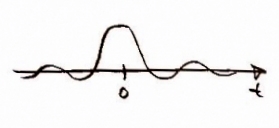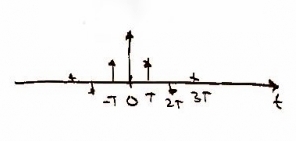HW8: Difference between revisions
No edit summary |
No edit summary |
||
| Line 13: | Line 13: | ||
[[Image:x_discrete_a.jpg ]] [[Image:x_frequency2a.jpg]]<br> |
[[Image:x_discrete_a.jpg ]] [[Image:x_frequency2a.jpg]]<br> |
||
Represented as: <math> \sum_{n=-\infty}^{\infty}x(nT) \delta (t-nT_{0})</math> and <math>\frac{1}{T}\sum_{n=-\infty}^{\infty}X(f-\frac{n}{T})</math> respectively. |
Represented as: <math>x(t) = \sum_{n=-\infty}^{\infty}x(nT) \delta (t-nT_{0})</math> and <math>X(f) = \frac{1}{T}\sum_{n=-\infty}^{\infty}X(f-\frac{n}{T})</math> respectively. |
||
This type of sampling can result in aliasing. This is prevented by oversampling represented on CD players and other media devices as Nx for N times oversampling. It is commonly seen at 8 or 16 and my latest player had it at 52. For this particular assignment we were asked to look at digital filtering but we can accommodate for any oversampling with the variable 'p'. We will use a FIR filter for this. |
|||
Revision as of 00:47, 25 November 2009
Problem Statement
Write a section describing how a CD player works with out oversampling but with digital filtering (1x oversampling)
Solution
CD players are used to play audio files and although these are limited we can look at any non periodic signal as periodic with an infinite period. We can represent this signal, x(t) as such in the time domain and X(f) in the frequency domain.
In order to take the signal and read it digitally we must sample it. This gives us data points creating a discrete function of time , where is and integer and is the period between samples. We use a frequency of 44 kHz as it is twice the frequency at which a human can hear (i.e. 2 x 22 kHz) -- that means, kHz. Mathematically sampling is represented by multiplying x(t) with the delta function which results in a convolution with X(f).
Represented as: and respectively.
This type of sampling can result in aliasing. This is prevented by oversampling represented on CD players and other media devices as Nx for N times oversampling. It is commonly seen at 8 or 16 and my latest player had it at 52. For this particular assignment we were asked to look at digital filtering but we can accommodate for any oversampling with the variable 'p'. We will use a FIR filter for this.









